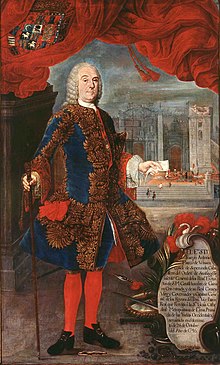José Antonio Manso de Velasco
|
Don José Manso de Velasco Conde de Superunda Caballero de Santiago |
|
|---|---|
 |
|
| 30th Viceroy of Peru | |
|
In office 1745–1761 |
|
| Monarch | Ferdinand VI |
| Prime Minister | Marquis of Ensenada |
| Preceded by | José Antonio de Mendoza |
| Succeeded by | Manuel de Amat |
| Royal Governor of Chile | |
|
In office November 1737 – June 1744 |
|
| Monarch | Philip V |
| Preceded by | Manuel de Salamanca |
| Succeeded by | Francisco José de Ovando |
| Personal details | |
| Born | 1688 Torrecilla en Cameros, Spain |
| Died | May 6, 1767 (aged 78–79) Granada, Spain |
| Children | Diego Manso de Velasco |
| Profession | Brigadier General |
| Religion | Catholic |
José Antonio Manso de Velasco y Sánchez de Samaniego (Spanish: José Antonio Manso de Velasco y Sánchez de Samaniego, primer Conde de Superunda) (1688 – May 6, 1767) was a Spanish soldier and politician who served as governor of Chile and viceroy of Peru.
Manso de Velasco served as governor of Chile from November 1737 to June 1744, during which time he stood out for his numerous projects. His tenure saw the construction of the first public food market in Santiago, irrigation canals on the Maipo River as well as breakwaters on the Mapocho River, the rebuilding of Valdivia (destroyed by an earthquake), and the celebration of an armistice with the indigenous Mapuche people, signed in the "Parlement of Tapihue".
In addition, he founded a large number of Chilean cities listed here with their current names, their given names, and their date of founding:
His efficiency and diligence recommended him to a higher post, and Ferdinand VI named him viceroy of Peru in 1745, making him the first governor of Chile to be elevated in such a manner.
Manso de Velasco was the viceroy of Peru during the reign of Ferdinand VI of the House of Bourbon, holding the office from 1745 to October 12, 1761. He succeeded José Antonio de Mendoza, 3rd Marquis of Villagarcía and was replaced by Manuel de Amat y Juniet. The most important event of his tenure was the great earthquake of 1746.
On October 28, 1746 at around 10:30 at night, a major earthquake struck Lima and vicinity, resulting in one of the highest number of deaths for such an event in the area. Witnesses differ on the duration of the event, with reports ranging from 3 to 6 minutes. The intensity of the quake is today estimated at X or XI on the Mercalli intensity scale. The aftershocks, by the hundreds, continued for the following two months.
...
Wikipedia
